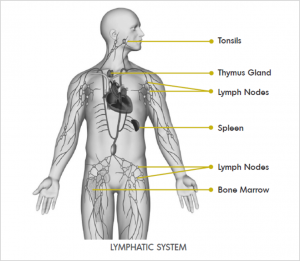
The lymphatic system consists of lymphatic vessels that are connected to lymph nodes, where the lymph is filtered. The lymph help rid the body of toxins, waste and other unwanted materials. There are hundreds of lymph nodes in the body, they are located deep inside the body such as around the lungs and heart. They are also close to the surface, such as under the arm or groin. The tonsils, adenoids, spleen and the thymus are all part of the lymphatic system. The spleen is the largest lymphatic organ, it sits right above the kidney on the left side and controls the amount of red blood cells and blood storage in the body, and helps to fight infection. The thymus is located in the chest just above the heart. This small organ stores immature lymphocytes (specialized white blood cells) and prepares them to become active T cells, which help destroy infected or cancerous cells.
What does the lymphatic system do?
The primary function of the lymphatic system is to transport lymph, a fluid containing infection-fighting white blood cells, throughout the body. The lymphatic system helps keep the body healthy by eliminating infections and diseases.
What does cupping do for the lymph?
Regular lymph cupping helps improve your immunity! Increasing lymphatic output increases the immune system’s ability to detoxify the body and respond to stressors put onto it from disease, chemicals, stress and electromagnetic fields. If your lymph is struggling, your thoracic ducts can swell. This increases pressure on the surrounding nerves, causing your hand or arm to fall asleep. Lymph stagnation causes headaches that start as pressure in the back of your neck and can make the top of your head, behind your sinuses, or whole head feel pain.
Cupping stretches open, rather than closing the lymphatic vessels. This action actually increases the movement of lymph locally and systemically with cumulative treatments.
For more information, Visit us at https://www.maryamcollahi.com/
Image source: https://bit.ly/3AxFhc7

Leave a Reply